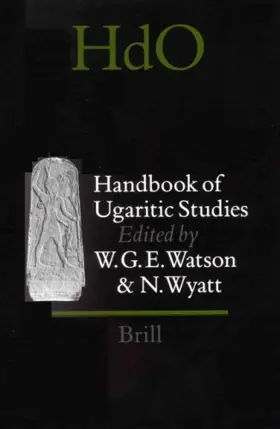

Handbook of Ugaritic Studies (Handbook of Oriental Studies/Handbuch Der Orientalistik)
Pages
892
Publisher
Brill
Published
7/1/1999
ISBN-13
9789004109889
This work deals with all important aspects of Ugarit, such as the decipherment of a previously unknown script used to write both Ugarit and Hurrian, their grammar and vocabulary; documents in other languages together with the literature and letters of the ancient kingdom of Ugarit.
Reviews
Ugarit specialists discuss the discoveries, culture, religion, and history of the city and its texts.
[Full Review]
Handbuch der Orientalistik. Erste Abteilung, Nahe und 39 Leiden: Brill, 1999. Pp. xiv + 896, Cloth, No Price Available, ISBN 9004109889. Raymond de Hoop Groningen, the Netherlands The Handbook of Ugaritic Studies is a massive volume, containing a wealth of information on all aspects of the study of the heritage of the ancient city of Ugarit. The editors, Wilfred G. E. Watson and Nicolas Wyatt are undoubtedly to be congratulated on its publication because its production has been a tour de force. They had to follow up the original editor, Johannes C. de Moor, who drew up the outline of the volume and contacted contributors but then withdrew himself for personal reasons. But, certainly the most frustrating (or even “traumatic”, p. xiii) experience must have been the fact that several contributors withdrew from the project sometimes at a rather late stage. For example, the entire membership of the Mission de Ras Shamra withdrew from the project, hence the reason why their names are missing from the list of contributors (p. xii). However, the Handbook of Ugaritic Studies has been finally published and it was useful that the edit ors having reported their troubles, otherwise one would have wondered why some prominent names are missing in the list of contributors, even though it would be impossible to find a name that should be replaced by another one. The Handbook provides a wealth of information on Ugaritic Studies, written by the leading scholars in the field. Of course, the Handbook of Ugaritic Studies is not the first or only work giving information on this subject. Recent encyclopaedia entries are to be found in ABD: on the history and archaeology (M. Yon, vol. vi, pp. 695-706), texts and literature (D. Pardee - P. Bordreuil, vol. vi, pp. -706-721) and language (J.F. Healey - P.C. Craigie, vol. iv, pp. 226-229).
[Full Review]

